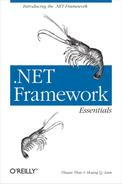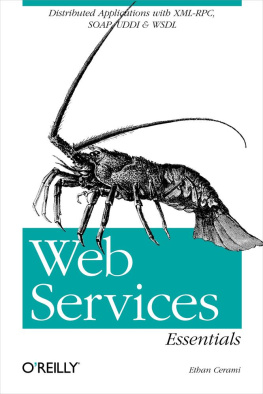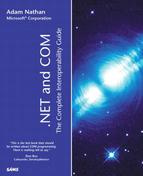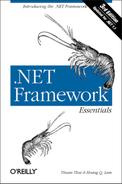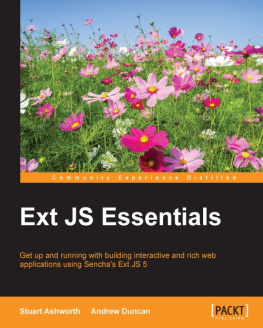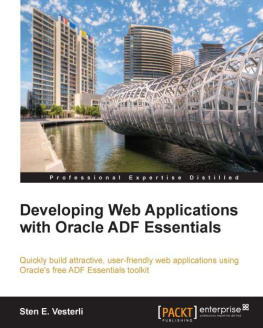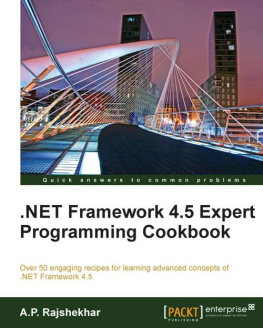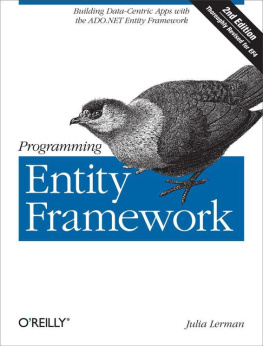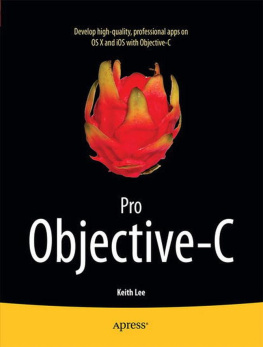A condensed introduction to the Microsoft .NET Framework, this bookaims to help programmers make the transition from traditional Windowsprogramming into the world of .NET programming. The Microsoft .NETFramework includes the Common Language Runtime (CLR) and a set ofbase classes that radically simplify the development of large-scaleapplications and services. This book examines the CLR in detail, sothat you can put its new features to good use. The book alsoillustrates how language integration really works and guides youthrough component and enterprise development using the .NETFramework. In addition, it introduces you to four key .NETtechnologies: Data (ADO.NET) and XML, Web Services, Web Forms(ASP.NET), and Windows Forms.
We used Beta 2 of the .NET SDK to prepare this manuscript and todevelop all the examples and figures in this book. While we have doneour best to ensure that the technical content of this book isup-to-date, it is possible that some items have changed slightly fromthe time of writing. By the time this book gets to you, there may bea newer release. Also, check http://msdn.microsoft.com/net, http://www.gotdotnet.com, and theOReilly web page for this book, http://www.oreilly.com/catalog/dotnetfrmess/, regularly.
About This Book
Based on a short course that Thuan has delivered to numerouscompanies since August 2000, this book is designed so that eachchapter builds on knowledge from the previous one for thoseunfamiliar with each technology. To give you a heads-up, here arebrief summaries for the chapters and appendixes covered in this book.
takes a brief look at Microsoft .NETand the Microsoft .NET Platform. It then describes the .NET Frameworkdesign goals and introduces you to the components of the .NETFramework.
lifts the hood and peers into the CLR.This chapter surveys the rich runtime, as well as other features, ofthe CLR.
introduces you to .NET programming.Youll examine a simple program that uses object-oriented andcomponent-based concepts in four different languages: Managed C++,VB.NET, C#, and IL. Youll also experience the benefits oflanguage integration.
demonstrates the simplicity ofcomponent and enterprise development in .NET. Besides seeingcomponent-deployment features, youll also examine completeprograms that take advantage of transaction, object pooling,role-base security, and message queuingall in one chapter.
describes the architecture of ADO.NETand its benefits. Besides being disconnected to promote scalability,the ADO.NET dataset is also tightly integrated with XML to enhanceinteroperability. This chapter introduces you to the .NET data-accessobjects, as well as the XML namespace.
describes the next generation ofsoftware components, ones that can be accessed through the Internet.In this chapter, we discuss the protocols that support Web Services,as well as how to publish and discover them. You will see how XML,used in conjunction with HTTP, breaks the proprietary nature ofcurrent component-oriented software development and enables greaterinteroperability.
introduces you to ASP.NET, which nowsupports object-oriented and event-driven programming, as opposed toconventional ASP development. In this chapter, Web Forms and servercontrols take the center stage. In addition, we examine how to buildcustom server controls, perform data binding to various .NETcontrols, and survey state management features in ASP.NET.
takes conventional form-basedprogramming a step into the future with the classes in theSystem.Windows.Forms namespace. Similar to Win32-based applications,Windows Forms are best used for to build so-called rich orfat clients; however, with the new zero-effortinstallation procedure of .NET and the advent of Web Services,Windows Forms are appropriate for a host of applications.
contains a list of links to web siteswith information regarding languages that targets the CLR, includingsome burgeoning open source projects.
contains a list of commonly usedacronyms that are used in .NET literature and presentations.
contains several lists of commonly useddatatypes in .NET. This appendix also illustrates the use of severalof its collection classes.
surveys the important tools that the.NET SDK provides to ease the tasks of .NET development.
Now that you know what this book is about, we should explain whatthis book is not about. This book does not focus on the marketingaspects of .NET or on other components of the .NET Platforms,including .NET Enterprise Servers, .NET Building Block Services, or.NET Operating Systems. Likewise, we do not cover the recentlyannounced HailStorm service or the work Microsoft is doing to makethe .NET Framework available on a host of devices.
Assumptions This Book Makes
This book assumes that you are a Windows and web applicationdeveloper fluent in object-oriented and component-based programming.It also assumes that you have some basic knowledge of XML. While COMis not a crucial prerequisite, if you have COM programmingexperience, you will appreciate this book and the .NET Framework allthe more.
Conventions Used in This Book
We use the following font conventions in this book:
Italic is used for:
Pathnames, filenames, and program names
Internet addresses, such as domain names and URLs
New terms where they are defined
Constantwidth is used for:
Command lines and options that should be typed verbatim
Direct quotes and specific method names from code examples, as wellas specific values for attributes and settings within code
XML element tags
Constantwidthbold is used for:
Constantwidthitalic is used for replaceable items incode, which should be replaced with the appropriate terms.
In code syntax examples, we occasionally use[value] +to represent one or more instances of a value and[value] *to mean zero or more instances of a value.
How to Contact Us
We have tested and verified the information in this book to the bestof our ability, but you may find that features have changed (or eventhat we have made mistakes!). Please let us know about any errors youfind, as well as your suggestions for future editions, by writing to:
| OReilly & Associates, Inc. |
| 101 Morris Street |

